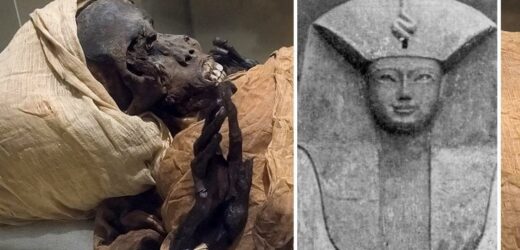Seqenenre Tao shocking origins explained
We use your sign-up to provide content in ways you’ve consented to and to improve our understanding of you. This may include adverts from us and 3rd parties based on our understanding. You can unsubscribe at any time. More info
Archaeologists and researchers have been drawn to the banks of the River Nile for decades, amazed by the advanced ancient civilisation that once frequented Egypt. Just this week, archaeologists uncovered the remains of a temple built to honour the ancient Greek god Zeus in the Sinai Peninsula. The area was known as Pelusium in Greco-Roman times (332BC to 395AD), and was a thriving city and port on the far eastern mouth of the Nile.
Archaeologists continue to discover evidence of an extremely advanced civilisation, with just a few of their finds documented in a Smithsonian Channel documentary detailing the amazing secrets of Egypt’s ancient ancestors.
Among the staggering finds was an ancient pharaoh whose life, and death, is shrouded in mystery.
Discovered by locals in 1871, and by Egyptologists ten years later, the Royal Cache is an Ancient Egyptian tomb containing the mummified remains and funeral equipment of more than 50 kings, queens, and other royal family members of the New Kingdom.
Alongside legendary kings like Ramesses the Great and Seti I, there was a little-known pharaoh whose reign remains riddled with questions.


An inscription on the lid of his coffin reads ‘Seqenenre the Brave’, offering the first clue into how he died.
Dr Richard Shepherd is a world-renowned forensic pathologist specialising in the investigation of suspicious deaths.
He told the documentary: “When we look at the front of his face, it certainly doesn’t look normal. It’s very distorted…
“The whole of the nose, the eye on the right, the bridge of the nose, the eye on the left are all very distorted.”

Seqenenre is the only mummified pharaoh ever found with such violent injuries.
Pointing out horrific wounds to the side of Seqenenre’s head, Dr Shepherd said: “This is a wound that’s been forced in.
“It’s been smashed into his brain, producing this large crater-like effect.
“This wound has a slightly different appearance, partly because I think a bit of the bone has broken off, possibly as the weapon was removed.
DON’T MISS:
Archaeology discovery in UK as ex-MP unearths mysterious ancient axe [REVEALED]
Archaeologists solved mystery behind Tutankhamun’s tomb [INSIGHT]
‘Lost world of shipwrecks’ amazed researchers: ‘Never been seen before [REVEALED]

“It’s flipped a piece of the outer part of the skull off.”
Dr Shepherd sought to understand how Seqnenre died, turning to the only full autopsy ever performed on Seqenenre’s body.
Elliot Smith performed the autopsy in 1912, and concluded that Seqenenre died from axe wounds received in battle.
Dr Shepherd said: “Elliot Smith says ‘axe’ in his report, and I’d back it up forensically from our knowledge now.
Tutankhamun's tomb theories debunked by expert
“When I look at these two injuries, what I can say is that they are both lethal wounds, and you’d probably only need one of them to cause death, but the two together are a certain cause of death.”
A vivid description of Seqenenre’s death can be found in Gaston Maspero’s 2005 book ‘History Of Egypt, Chaldaea, Syria, Babylonia, and Assyria, Volume 4’.
Mr Maspero wrote: “A blow from an axe must have severed part of his left cheek, exposed the teeth, fractured the jaw, and sent him senseless to the ground; another blow must have seriously injured the skull, and a dagger or javelin has cut open the forehead on the right side, a little above the eye.
“His body must have remained lying where it fell for some time: when found, decomposition had set in, and the embalming had to be hastily performed as best it might.”
It is widely believed that the wounds to his head were caused by a Hyksos axe, and further wounds to his neck were from a dagger when he was lying on the ground dying.
The lack of wounds to his arms and hands also suggest that he had been unable to defend himself.
A 2021 CT scan revealed Seqenenre was in his forties when he died, and his deformed hands suggest he had been imprisoned with his hands tied.
Seqenenre’s facial wounds also correlated well with the Hyksos weapons, suggesting he might have led military skirmishes against the Hyksos and died during one of these.
Source: Read Full Article


